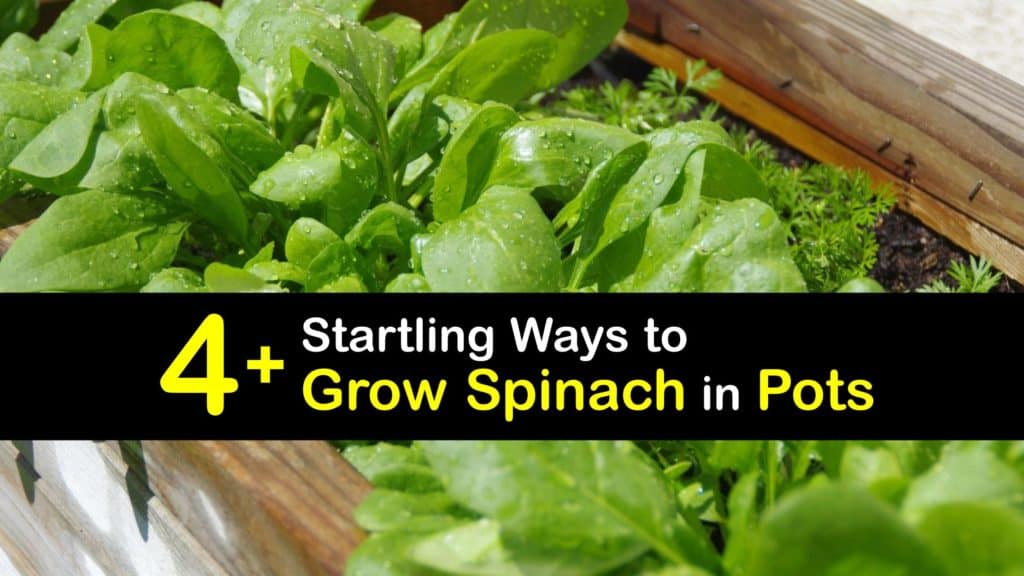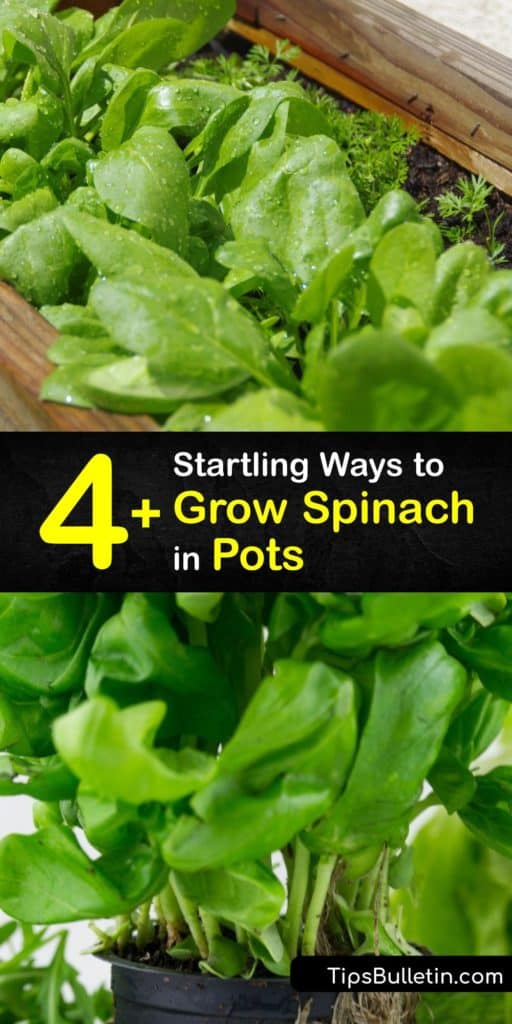Gardening at home is the perfect way to take charge of eating a healthy diet while supplying yourself with fresh and organic produce. If lack of garden space keeps you from growing a yard’s worth of delicious leafy greens like spinach, it’s time to start container gardening. Learn how to grow spinach in a pot and create a vegetable garden inside your home.
Growing spinach in a container is ideal because spinach plants aren’t known as voracious growers, meaning they won’t take over your home with vines like other crops. By growing in containers, you control your plant’s growing conditions and reduce the risk of pests targeting its leaves before harvesting them.
Like Swiss chard and other dark green vegetables, spinach is highly nutritious. It is a great source of vitamins A and K. A single serving of spinach also provides a fair amount of potassium and thiamin or vitamin B. For an easy and healthy crop to plant-spinach is your best choice.

Tips for Growing Spinach in Pots
To ensure your spinach seeds are successful and make it to harvest, keep in mind that all types of spinach plants are cool-season crops that start bolting when temperatures rise. By growing spinach in pots, you control where your plant grows, and relocating your plant to a suitable location is simple.
When to Start Planting Spinach in Pots
Spinach plants take about 40 days to reach maturity. This timeline is essential when growing spinach in the garden and is relevant if you plan on leaving your spinach pots outside on the patio. Because spinach enjoys cool weather, gardeners living in growing zones five through ten have the best weather for successive plantings of spinach.
Whether you are planting spinach in pots or outside, start your seeds in early spring for the best chance of your spinach reaching maturity without bolting. Spinach thrives when grown in full sun, but as temperatures in your area rise, relocate your spinach to a space with partial shade to prevent bolting.
Selecting a Type of Spinach to Grow
Before growing spinach in pots, pick a type of spinach. The kind of spinach found in the grocery store has smooth leaves; however, another kind exists with crinkly spinach leaves. This spinach is known as savoy spinach, and it has a unique look and excellent taste.

This spinach holds up longer after harvesting and contains less oxalic acid than smooth types. Savoy spinach is a preferred choice for home gardens and farmer’s markets.
Tyee is savoy spinach that reaches maturity in roughly 40 days. It grows upright, which allows its leaves to grow cleaner, resistant to some downy mildew, and bolt-resistant.
Bloomsdale Longstanding spinach is an old variety with zero resistance to disease that reaches maturity in around 50 days. This type of spinach grows large leaves and is ideal for harvesting in early summer. After applying mulch, the plant is capable of overwintering in the garden.
Regal spinach is a semi-savoy variety; its leaves are only lightly crinkled. It is resistant to fungal diseases like downy mildew, and its baby leaves are ready for harvest in 30 days.
Note: Although New Zealand spinach exists, it is not a type of spinach. The leaves of New Zealand spinach (Tetragonia tetragonioides) are fuzzier and smaller than regular spinach; however, after cooking, it looks very similar to spinach.
Companion Planting Spinach Indoors
If you are familiar with outdoor gardening, the concept of companion is nothing new, but the benefit of planting beneficial plants is obtainable even when planting spinach in pots. The main requirement for a successful container partnership is to ensure your plants have similar growing conditions.
Marigolds and nasturtium are flowering plants that add color to any room, and their flower petals are edible, making them perfect for adding to any salad with your spinach. As a cool-season crop, parsley enjoys the same kind of growing conditions and soil temperature as your spinach.
Beans are a universal companion plant because of their ability to fix nitrogen levels in the soil. To grow spinach and beans together, select a larger pot to plant beans and add spinach around the bean seeds.
How to Grow Spinach in a Pot
Start spinach plants from seeds in pots at least six inches across. Amend your loamy potting soil with compost and measure the soil pH before planting. For your plants to thrive, they need soil pH between 6.0 and 7.0.
For the best and fastest way to grow spinach from seed, sow several seeds into the pot, with a spacing of one inch between each seed, and cover with potting mix. Follow the same procedure to grow kale in pots. Well-draining soil is essential to keep your soil moist without causing your plant to sit in water. To help with water retention, add a layer of organic matter mulch around your spinach plant’s base.
Like when you are planting collard greens in containers, leave your spinach pot in a location to receive full sun to promote germination. As your plant grows, it requires a lot of water and food to produce a healthy yield. To provide your spinach with nutrients, use a fish emulsion liquid fertilizer to provide spinach with a heavy dose of nitrogen.
Caring for Container Grown Spinach
One of the most notable benefits of growing spinach in pots is avoiding soil-borne diseases and pests like slugs that roam your garden. If you leave your pots outdoors, you may find your plant under attack from other problems like aphids.
Green peach and potato aphids are tiny insects that feed on the leaves of plants to suck out the sap inside. After feeding, aphids leave honeydew on the leaves, which leads to sooty mold. Kill aphids on sight using a DIY insecticide spray made from rubbing alcohol and soap.
Mix the ingredients in an eight-ounce spray bottle to create a quick insecticide. Spray the whole plant with this solution to kill insects and prevent more from gathering on your spinach plant.
Harvesting and Using Spinach Grown in Pots
When you harvest spinach depends on what kind of leaves you want: baby or full-grown. What is baby spinach? Baby spinach leaves are immature and have a sweeter flavor.
The best practice for harvesting spinach involves snipping a few outer leaves and allowing the plant to continue growing before harvesting again.
Because spinach wilts quickly after harvest, this method allows you only to harvest what you need and save the rest for later. Harvest your leaves once they reach complete leaf formation and before they turn yellow. Start by cutting the outer leaves with scissors.
Bring your spinach inside and thoroughly rinse the leaves before using or storing them. Fresh spinach keeps in the refrigerator for up to two weeks in a plastic bag.
Preheat your oven to 350°F and place a baking sheet over a baking tray. Place your spinach in a large bowl and drizzle with oil, then lay the spinach on your baking tray. Mix your seasonings in a bowl before sprinkling over your spinach. Bake in the oven for up to ten minutes, monitoring to avoid burning them. Allow the spinach chips to cool before serving.
Growing at home in pots is something everyone can enjoy due to the minimal maintenance required to bring your plants to harvest. After discovering how easy it is to care for spinach and enjoy the taste of fresh spinach during dinner, you’ll never put up with prebagged veggies again.

If you learned how to grow spinach in a pot, please share our tips on planting spinach in pots with your fellow gardeners on Facebook and Pinterest.